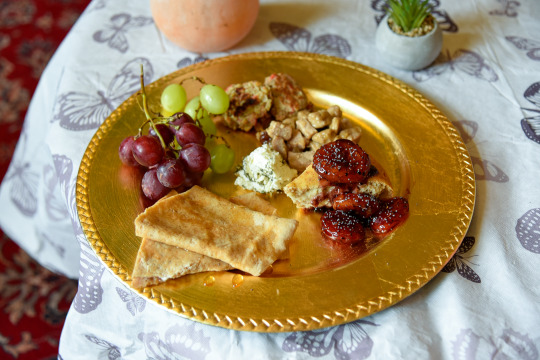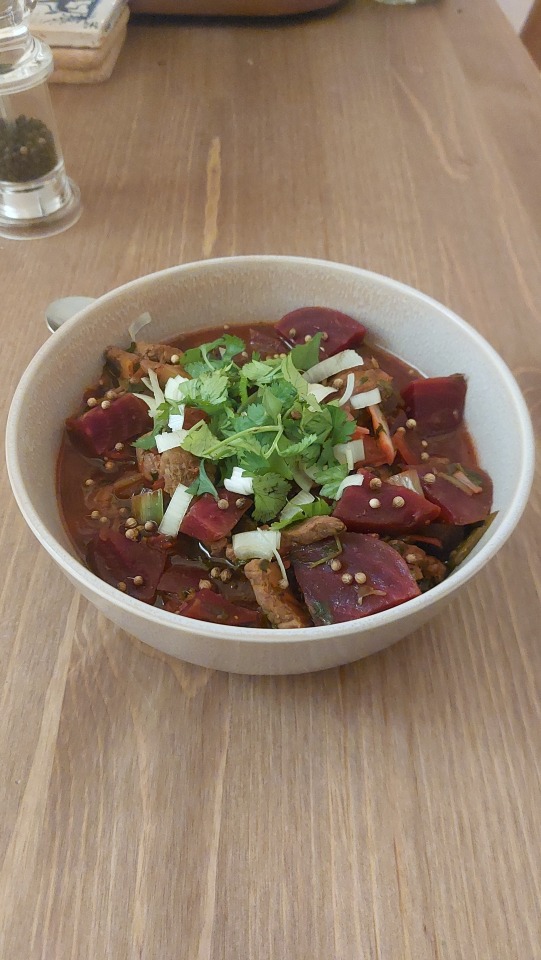#ancient cooking
Explore tagged Tumblr posts
Text


DULCIA DOMESTICA (ROMAN STUFFED DATES, 1st c.)
To get us through this workweek, I snuck in a mid-week Tasting History recipe - a little something sweet to get us through the next few days of work: Dulcia Domestica (directly translated as homemade sweets), a Roman recipe for stuffed dates from the 1st century. This is one of the very few dessert items mentioned in the earliest Roman cookbook, De Re Coquinaria of Apicius. These specific stuffed dates were a snack available at Ancient Rome's Colosseum during gladiatorial games, among other snacks like sausages and pastries, and they may also have been launched over the crowd as little prizes, like a predecessor to the modern stadium's T-shirt cannon! Most attendees, however, would buy these date snacks from concession workers roaming the aisles of each seating section, much like at stadiums today. The trade of the dulciarius, the sweet shops which produced these stuffed dates, was highly developed at the time of Apicius, to the point that professional bakers and confectioners supplied the entire home market with their sweets, making it rare for a home cook to try and make these themselves. This is largely the same today - making candy is a difficult process, best to leave it to Haribo and the like! This recipe seemed quick and not too laborious, so I just had to try it. I also really wanted to taste an Ancient Roman stadium snack! See Max’s video on how to make this dish here or see the ingredients and process at the end of this post, sourced from his website.
My experience making it:
First off, I halved the recipe (as I often must do with Tasting History recipes), and I decided to use only pine nuts, since I don't really like walnuts. I found some nice, big Medjool dates at the grocery store today on a whim, it seemed meant to be! For the honey, I used German sunflower honey, and I used plain black pepper.
I started by measuring out the honey into a saucepan. Well, I eyeballed it since my honey was quite thick and gloopy. I then sliced the dates open length-wise and removed the pits. Next I crushed the pine nuts with a mortar and pestle. Unfortunately, I seemed to have gotten carried away with this, and I think I may have crushed the pine nuts into too much of a soft crumble. Mine looked less chunky than Max's, at least. Perhaps walnuts are harder to crush? I added the pepper to the crushed pine nuts and mixed until uniform. Next, I stuffed the dates full of the nut mixture with a small spoon, then used the dates' sticky juices to try and seal them up again. It worked fairly well! I prepared a small plate of sea salt and rolled each date in it. I was actually quite surprised to see how well the fine grains of salt stuck to the dates, since the outside of the dates didn't seem very sticky. I warmed up the honey on the stove, and let it bubble for 10 minutes, having to turn the heat down only once due to it boiling up a little too high in the pot. Luckily I caught it before it made a terrible mess from boiling over! I placed each of the dates in the pot and ladled the bubbling honey over each of them with a spoon. They didn't open up at all or lose their filling, which was perfect. I let them cook just over a minute, then scooped them up and let them sit on some tinfoil to cool while my husband and I ate dinner. I transferred them to a plate after, and dessert was ready to be served!
My experience tasting it:
Biting into the stuffed date, the first thing I tasted, overwhelmingly so, was sweetness. However, the salt also came through strongly. I had never really put honey and salt together before in any recipes, but maybe I need to start - what a great combo! I did wish I could taste more pepper, though, since I thought that would add more of a spice. Maybe black pepper is too subtle, and I should have used long pepper instead. Texture-wise, I was not really a fan of this recipe. I had a feeling this would be the case going in, as I am not a huge fan of the texture of dates in general, despite liking their taste. I was expecting more texture from the pine nuts, but I must have ground them too small, as they almost felt like a paste on my tongue. Not my favourite. My husband seemed to like them, however, as he tossed them back and suggested I share the recipe with his mom (will do!). I'm on the fence about this recipe overall, and I'm not sure if I will make it again. If I do, I will not mince the pine nuts to a pulp like I did this time, and I would add more pepper to the mix. I might also take one Tasting History viewer's suggestion and mix the honey with the nut mixture instead of cooking the dates in it, in an effort to tame the sweetness a little. Perhaps I have much to learn from Ancient Rome's dulciarii - I'm sure their versions were much tastier, with the perfect ratio of ingredients. If you end up making this dish, if you liked it, or if you changed anything from the original recipe, do let me know!
Dulcia Domestica original recipe (1st c.)
Sourced from De Re Coquinaria of Apicius (1st c.).
Little home confections (which are called Dulciaria) are made thus: Little palms or (as they are ordinarily called) dates are stuffed - after the seeds have been removed - with a nut or with pine nuts and ground pepper, sprinkled with salt on the outside and are candied in honey and served.
Modern Recipe
Based on the recipe from De Re Coquinaria of Apicius (1st c.) and Max Miller’s version in his Tasting History video.
Ingredients:
15 to 20 large dates, such as medjool
1 cup (125 g) walnuts*
1/3 cup (45 g) pine nuts*
1 tsp black pepper or long pepper
1 cup (235 ml) honey
Fine sea salt
*You can use either all walnuts or all pine nuts if you want.
Method:
Slice the dates lengthwise on one side. Don’t cut all the way through, just enough to open them up so you can fill them. Remove pits if necessary.
Grind the walnuts and pine nuts in a mortar until it reaches the texture you desire.
Grind the pepper as finely as possible.
Mix the nuts and pepper until everything is evenly dispersed. Stuff the dates with the nut mixture. Pack as much of the stuffing as you can into each date, otherwise it’ll all fall out when you go to cook them. Close the date around the filling as much as possible, and continue until all the dates are filled.
Put the fine sea salt in a shallow bowl or plate and roll the stuffed dates in the salt.
Bring the honey to a simmer in a saucepan. Cook the honey for about 10 minutes, keeping an eye on it to make sure it doesn’t get too hot and boil over.
Add the dates to the honey, cut side up so the filling doesn’t come out. Spoon or push the honey over the dates and let them cook for about 45 seconds to 1 minute.
Remove the dates and set them on a plate, a piece of foil, or parchment to cool completely, about 10 minutes.
Once the dates have cooled and are a bit less sticky, serve them forth.
#max miller#tasting history#tasting history with max miller#cooking#keepers#historical cooking#europe#vegetarian recipes#desserts#dulcia domestica#ancient cooking#ancient rome#ancient history#roman meals#roman recipes#dates#honey#nuts#sweets#1st century#apicius#de re coquinaria#italy#snacks#roman history
3 notes
·
View notes
Text
Ancient Recipes: Apricot Dessert (Apicius, De re coquinaria)
Did you know when you Google Apicius, they call him a professional chef?

Given that he was the closest thing Ancient Rome had to Betty Crocker or Martha Stewart, we guess it makes sense. These apricots are a fantastic dessert from De re coquinaria (c. 5th cent. CE), arguably the best-known Ancient Roman cookbook. They likely would have been enjoyed at room temperature, but taste fantastic after being chilled. We make this at every rendition of our Ancient Food Day, and it's always a hit.
Latin: duracina primotica pusilla precoquiis purgas, enucleas, in frigidam mittis; in patina conponis; teres piper mentam siccam; suffundis liquids; adicies mel passum uinum et acetum; refundis in patina super precoquia, olei modicum mittis et lento igni ferueat, cum ferbuerit, amulo obligas, piper aspargis et inferes. (De re coquinaria, 4.177)
Translation (by John Liao): Wash firm, early or small apricots, pit them, and put them in the cold [water]. Arrange them in a pan. Crush pepper and dried mint, pour over liquamen and add honey, passum, wine and vinegar. Pour over the apricots in the pan. Add a little oil and heat on a low flame. Thicken [the sauce] with starch while it simmers. Sprinkle with pepper and serve.
Ingredients
10-12 apricots (pitted and halved if fresh, rehydrated in water overnight if dried)
1 ½-2 tbsp freshly cracked black pepper (plus extra for garnish)
1 tbsp dried mint flakes
1 tsp garum/liquamen (substitute fish sauce if you can't find/make it yourself)
3-4 heaping tbsp of honey
3/4 cup of red wine
3/4 cup of passum (also known as raisin wine. Substitutes can include cranberry juice (less sweet), grape juice (more sweet), or ice wine (if you don’t have to make this for a school event).
1 tsp of vinegar (2 tsp if you're not using passum/alcoholic passum substitute)
1 ½ tbsp of olive oil
½ tsp corn starch
3-4 tbsp cold water
Our Recipe
Soak halved, pitted fresh apricots in cold water for 15 minutes (skip if using rehydrated fruit)
In a wide pan (at least 3 inches deep), lightly toast the black pepper and mint at medium heat until fragrant.
Add the liquids: honey, passum, wine, vinegar, and liquamen. Bring to a simmer and stir until well incorporated, and the honey has dissolved. Continue simmering to cook off the alcohol. If the mixture begins to reduce too much, add water in small amounts.
Once the desired amount of alcohol has been cooked off, add the apricots. Continue simmering until apricots reach your desired texture (usually 8-12 mins).
Remove the apricots from the pan. Mix cornstarch with cold water into a slurry, and add to the remaining liquid. Stir and cook until thick, then pour over reserved apricots. Let cool.
Serve chilled or at room temperature, with fresh black pepper sprinkled on top.
Below, we served them with libum (Roman cheesecake) and statites (Ancient Greek spelt crepes).

Some more anachronistic ways to serve this can include using it as pie or tart filling, mixing it with Greek yogurt, or serving it with vanilla ice cream while it's still hot (sort of like a poached pear situation).
Some FAQs
Q. "How long do I actually boil the sauce?"
A. As long as you want, depending on how much alcohol you want in the dish (we serve these at school events, so we have to boil it to hell and back to get rid of all the alcohol).
Q. "The ancient recipe says to cook the apricots first, why do you make the sauce first?"
A. When we tried the apricot-first method, the apricots fell apart and turned the whole thing into a jam-like stew because of how long we had to cook the sauce. It tasted great but lacked the nice texture of the whole apricots.
Q. "Can I substitute ingredients 1-1?"
A. Generally, yes. For our passum substitute, we use cranberry juice for its tartness, but any of the three substitutes work. However, if you have the ability to make/buy garum and passum, definitely give it a try!
#the pie version slaps btw i made it for thanksgiving#you just put the apricots and sauce (with cornstarch slurry but no extra cooking) in a blind baked pie shell#and then tuck it into the oven at 375 for about 10 minutes or until the sauce is thick#ancientfoodday#tagamemnon#classics#apicius#ancient rome#classics recipes#cooking#ancient cooking#recipe#ancient history#history#roman history#tagitus
17 notes
·
View notes
Video
youtube
The Indus Valley: 100% Healthy Cookware🤩 For Extra 12% discount, use cod...
1 note
·
View note
Photo
I suddenly feel an indescribably deep call to get a grinding stone and grains and honey and some wild yeasts from the local meadow...
(This urge is exactly why the very expensive bespoke grainery here in town does so well. They sell packages that'll last you 3-4 loaves, just enough to get the process going in the right direction, and then you're hooked on your high-hydration, locally yeasted blend of ancient wheats, millet and barley.)

figurine of a woman baking, 8th-6th century bce, pottery, akhzib
27K notes
·
View notes
Text

#cult of the lamb#cotl#my art#cotl narinder#cotl lamb#narilamb#cotl au#cotl fanart#cotl narilamb#cryptid swap au#cotl toww#i think they like to hold him like that#like gripping a plushie by its face type hold#also i FINALLY managed to get my hands on an ipad u guys r so cooked#hopefully I’ll have time to do the cotl drawtober but I’ll probably have to do easy mode since I haven’t finished my wip prompts yet loll#also my ancient apple pencil doesn’t connect to my ipad so I have to get another one eventually :( using a stylus in the meantime
1K notes
·
View notes
Text



















you think YOU had a bad day at work?
bonus: sid shrieking "no!!!! NO!!!!!" loud enough to be heard in the stands and on camera
#this is now my FAVOURITE game i've watched in real life knocking the game misconduct one off the number one rank#he was so annoyed the entire game and so annoying about it :')#he kept shrieking away on the bench and i couldn't hear a word from where i was seated#but you could just hear this constant yipping away dhfsgfkjshgfsjf PLEASE it was so funny your 36-year-old babygirl was BARKING#drew kept sitting there like... is mom okay... i don't think mom's okay...#also extremely good for me (since he wasn't really hurt) was the whumpfest of it all oh my god what ancient gods did he anger.........#geno kept Hovering in concern#po kept giving him little shoulder pats the way a sweet brave babyboy would try his best to soothe a rabid little dog#ek of course kept trying to slide right inside him and also kept skating up to him and STARING him in the face in concern/lust/both#also guys this is my first time in canada ever!!!!!!!! i'm excited#anyway. very good game for me sorry for this post but you know i love a#long post#sidney crosby#evgeni malkin#pittsburgh penguins#also!!! to all who celebrate#ramadan kareem/eid mubarak#<333 staying with a friend here through the eid celebration and they've been cooking and everything smells so good
3K notes
·
View notes
Text

WHEN THE SUN IS FALLING
SHOULD I CHASE IT?
#nine sols#nine sols yi#collage cooked real hard with those bars. really hammers that feeling of the end/return#queues this song up for the 150th time#anthro#anthro art#Stuck spending too much time on memes cause the idea came to me in a split second and i had to see it through#The emotions these parts of the song fill me with is. immense#a very “its so over” yet also “its finally over”#edit: Youre all so real. The ancient dream line rattles in my head daily
1K notes
·
View notes
Text
hi op i just want you to know that i made this approximately 20 minutes ago for a latin project im working on (along with my homemade wheat bread, which i also learned how to make for this project) and it was the best soup i’ve had in literal years. i wasn’t expecting much, and then it was so good i almost cried. that may have been related to the leftover onions sitting next to me, but whatever.
thank you for giving me my new favorite recipe and most fulfilling thing i’ve had in a while.
Etruscan Aquacotta (jusellum) - The World That Was
Today, I’ll be making a simple bread-based soup - referred to as juscellum by Apicius! It’s a lot like Tuscan “aquacotta” soup, which is prepared in a similar way - though today it often includes tomatoes, which would not have been available in antiquity.
youtube
And now let’s take a look at The World That Was! Follow along with my YouTube video above!
Ingredients
1 onion 1 carrot 1 stick celery 3 cloves garlic thyme 2 slices bread (torn or grated) 2 eggs 750ml chicken stock olive oil salt pepper
Method
1 - Chop Ingredients To begin with, we need to chop and dice an onion. You don’t need to worry about being too careful here, as they’ll soften up considerably while its cooking. Peel and dice a carrot or two - carrots and parsnips were considered to be the same vegetable to the Greeks and Romans, so either one works well here! Finally, deal with some celery by slicing it thinly.
2 - Sautee and Cook Toss a bit of olive oil into a pot, and place this over a medium heat. When it’s shimmering, toss in your onions, carrots, and crush a few crushed cloves of garlic. Let this sauté away for about 10 minutes.
When it’s finished sautéing, pour in 500ml worth of water or chicken stock. On top of this, toss some chopped thyme Place your soup over a high heat, and bring it to a rolling boil. When it hits a boil, turn the heat down to low and let it simmer away for 30 minutes.
3 - Prepare Soup and Eggs While your soup is cooking, go rip up some slices into large chunks. Alternatively, you could grate up dried bread into a powder. Toss your bread into the soup about 10 minutes before you’re serving it, along with your parsley.
About 5 minutes before you serve up your soup, place some eggs into the pot and let them hard-boil.
4 - Assemble Soup In a serving bowl, ladle in some of your soup, and place your poached egg on top of this. Garnish with a little fresh herb. And serve up warm!
The finished soup is very filling and flavourful - along with looking very colourful when finished! It’s quick and simple to make, which would have made it popular with the lower, poorer classes in ancient Roman and Etruscan societies - as this dish can be made using ingredients that are going off (such as stale or mouldy bread). It can be adjusted using seasonal vegetables and herbs, along with different kinds of eggs that would provided different taste profiles.
86 notes
·
View notes
Text
HISTORY OF COOKING , खाना पकाने का इतिहास
Cooking has been a part of human records for as long as we've existed as a species. Early humans learned to cook meals over open fires, which helped to make it extra digestible and also killed harmful bacteria.
The earliest evidence of cooking comes from burnt animal bones observed in caves in Africa, which date lower back to round 2 million years ago. Through the years, humans advanced extra state-of-the-art cooking strategies, along with boiling and roasting, and commenced to apply pottery to cook and store food.
As civilizations developed, so did their cuisines. The historic Egyptians, Greeks, and romans all had wonderful culinary traditions, and those have been motivated by the ingredients available of their areas as well as via exchange with other cultures. Read More
0 notes
Text
youtube
How to prepare a ritual offering to Mars Silvanus for the protection of the cattle, following the directions provided by Cato in De Agri Cultura, written in the 2nd century BCE.
1 note
·
View note
Text



JENNIFER JAREAU and EMILY PRENTISS in CRIMINAL MINDS 3x14 | 'Damaged'
#my girls <3#they're so pretty !!#this set is so ancient that it was made before i started slowing my gifs down which is why they're so speedy#jemily#jj jareau#jennifer jareau#jennifer jj jareau#emily prentiss#criminal minds#paget brewster#aj cook#cmedit#cm#criminal minds gif#luthqrs#luthqrsgifs#luthqrscm#crim s3#cm 3x14#damaged
684 notes
·
View notes
Text


TUH'U (c. 1740 BCE)
The next Tasting History dish I had to try was Babylonian Tuh'u, a beet and lamb stew. The recipe for this dish is from the Yale Tablets, ancient Mesopotamian cuneiform tablets from 1740 BCE held at Yale University. According to these tablets, Babylonians loved eating stew - this stew recipe was just one of many stamped into these tablets. Max really liked Tuh'u when he made it, and even said it wouldn't be out of place on a modern menu. It's very impressive to see the Babylonians making meals with complex flavour combinations that can even please the palatte of people thousands of years in the future. See Max’s video on how to make it here or see the ingredients and process at the end of this post, sourced from the Youtube description of the video.
My experience making it:
I made a simple change or two from the modern recipe below. I used beef instead of lamb, mainly because the butcher I usually source lamb from was closed this week (and it's otherwise hard to find where I live). Further, I didn't end up using any of the water that Max lists in the ingredients. In terms of beer, I used Erdinger Weißbier, since it is very easy to find where I live. Unfortunately, sour beer is much harder to find, so I didn't consider using it.
In terms of preparation, this recipe requires lots of chopping (meat, onion, leek, shallot, arugula, cilantro...) and a little bit of grinding in the mortar & pestle (cumin seeds and garlic). I was very excited to use my new mortar & pestle, I love it already! The cumin seeds smelled divine while I was crushing them. Due to the long simmer time, the recipe took me about 1 hour and 30 minutes to make. The broth doesn't really thicken like a normal stew, so I decided to leave a little liquid and not boil all of it away, as the broth usually retains lots of the flavour. Due to the beautiful colour of the beets and the pops of fresh green from the cilantro, this dish was visually pretty to look at once it was served. The result was, like Max said, a dish I could definitely see being served in a restaurant today. The Babylonians had good taste!
My experience tasting it:
I tried this one on my own since my husband got home from work pretty late. The first bites were full of flavour - particularly the cilantro's. The texture and pop of flavour from the dried coriander seeds were also present, as well as the cumin, onion, and beet flavour. The beef didn't add much flavour, but definitely soaked up the flavour of the dish like a sponge. I enjoyed every bite of this one, and even saved some for leftovers to have at work. I had a feeling I would like this dish, because I like all the ingredients, and especially beets. I wasn't so sure if my husband would like it, but when he got home, he enthusiastically finished his bowl at record speed, exclaiming at how good it was in between spoonfuls. We both agreed it is the best historical dish I've made yet, and the best dish I've made in a while otherwise. I would actually consider sharing this recipe with friends, especially since the ingredients are fairly easy to find, and the process is fairly simple. Not to mention, the outcome was delicious! If you end up making it, if you liked it, or if you changed anything from the original recipe, do let me know!
Links to harder-to-find ingredients:
Cumin Seed
Coriander Seed
Tuh'u original recipe (c. 1740 BCE)
Sourced from the Yale Babylonian Tablets
Tuh’u sirum saqum izzaz me tukan lipia tanaddi tusammat tabatum sikara susikillum egegerum kisibirrum smidu kamunum alutum tukammas-ma karsum hazannum teterri kisibirrum ina muhhi sipki tusappah suhutinnu kisibirrum isarutu tanaddi. Tuh’u. Lamb leg meat is used. Prepare water. Add fat. Sear. Add in salt, beer, onion, arugula, cilantro, samidu, cumin, and beets. Put the ingredients in the cooking vessel and add crushed leek and garlic. Sprinkle the cooked mixture with coriander on top. Add suhutinnu and fresh cilantro.
Modern Recipe
Based on the Yale Babylonian Tablets and Max Miller’s version in his Tasting History video.
Ingredients:
1 lb (450g) leg of lamb (or other meat), chopped in bite size pieces
3-4 tbsp oil or rendered fat
1 ½ tsp salt
2 cups (475ml) water (only to add if needed)
12 oz (350ml) beer (sour beer and German Weissbier preferred)
1 large onion, chopped
2 cups arugula, chopped
3/4 cup fresh cilantro, chopped
2 tsp cumin seeds, crushed in a mortar & pestle
2 large beets (approx. 4 cups), diced
1 large leek, minced
3 cloves garlic
1 tbsp dry coriander seeds
additional chopped cilantro for garnish
Samidu* (1 Persian shallot)
Suhutinnu* (Egyptian leek for garnish)
*These ingredients have no definite translation; the shallot and leek are the best guesses of scholars at Yale and Harvard Universities)
Method:
Add the oil/fat to a large pot and set over high heat.
Sear the lamb for several minutes in the oil until lightly browned.
Add the onions and let cook for 5 minutes.
Add the beets and let cook for 5 minutes.
Add the salt, beer, arugula, cilantro, samidu (shallot), and cumin and bring to a boil.
Mash the garlic into a paste and mix with the leek, then add to the pot.
Lower heat to medium and let simmer for approximately 1 hour, or until the beets and meat are cooked to your liking. Add water if you prefer.
Once cooked, dish it into a bowl and sprinkle with coriander seeds. Garnish with fresh cilantro and suhutinnu (leek).
#max miller#tasting history#cooking#tasting history with max miller#Tuh'u#Babylon#Beets#Beef#Mesopotamia#ancient history#ancient cooking#ancient meals#stews#keepers#18th century BC#beer#Mesopotamian meals#Ancient Babylon#middle east#Asia#Meat
8 notes
·
View notes
Text
University of Toronto Ancient Food Day
There's nothing university students like more than free food. If you live in the Toronto area and are interested in attending, please come! The event is open to everyone, especially prospective students who want to learn more about our program!

Not only does AFD have free food and amazing company, our recipes are translated by our undergrads studying ancient languages! It's a really fun time and Socrates will NOT be there so you can actually enjoy yourself.
#yes im screaming into the internet void#please come visit us#i will show you our loebs#ancientfoodday#tagamemnon#ancient history#classics#latin#the iliad#history#ancient cooking
8 notes
·
View notes
Text

listen listen listen ancient hero's aspect has a lot of potential if you guys would just let me cook for a minute just LET ME COOK


Drew ancient heros aspect for anon and kept thinking about moro and had to draw ancient hero doing moro laugh
#peachmoths art tag#tears of the kingdom#legend of zelda#the legend of zelda#loz tears of the kingdom#loz totk#legend of zelda fanart#totk fanart#loz fanart#tloz fanart#tloz#totk#ancient hero aspect#let me cook on heros aspect LET ME COOK
218 notes
·
View notes
Text















I had. An Idea.
#CROSSOVER THAT MAKES NO SENSE BUT ITS FUNNY 2 ME#mashes the shows ive fixated on together#arguably Chopper is not beating an ancient elemental god but he'd hold out way longer than Skrael expects him to#I have so many more ideas my brain is like a frying pan im in the kitchen cooking i swear#my art#siggsart#one piece#tales of arcadia#3below#skrael of the north wind#varvatos vex#krel tarron#jim lake junior#toby domzalski#blinky galadrigal#arrrrgh#barbara lake#douxie#douxie toa#monkey d. luffy#tony tony chopper#roronoa zoro#cat burglar nami#usopp#black leg sanji#nico robin
300 notes
·
View notes
Text
youtube
Ancient Egyptian Spiral Bread of the Pharaoh
from Tasting History with Max Miller
77 notes
·
View notes